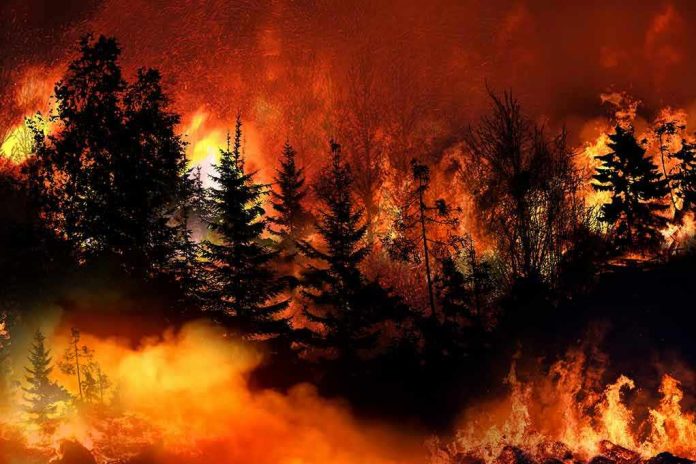
As the Grand Canyon’s North Rim smolders in ruins, Arizonans are demanding to know why federal officials let a lightning-sparked wildfire rage unchecked until historic American landmarks were reduced to ashes.
At a Glance
- Governor Katie Hobbs has called for a federal investigation into the National Park Service’s wildfire response.
- The Grand Canyon Lodge and other historic structures were destroyed after officials opted for a “confine and contain” strategy rather than immediate suppression.
- Fire behavior quickly escalated, overwhelming initial containment plans and forcing mass evacuations.
- The North Rim is now closed for the entire 2025 season, devastating local economies and tourism.
Federal Fire Strategy Leaves North Rim in Ruins
No one who loves this country—or its most treasured landscapes—can look at the charred remains of the Grand Canyon Lodge and accept the bureaucratic double-talk that’s followed. On July 4, a lightning strike sparked a wildfire on the North Rim, home to the historic lodge built in the 1920s. Instead of moving quickly to put the fire out, the National Park Service chose a “confine and contain” approach—government-speak for letting Mother Nature run wild as long as it stays inside some imaginary lines. Hot temperatures, gusty winds, and bone-dry conditions made those boundaries meaningless. By July 12, the fire’s “extreme and volatile” behavior had blown past whatever containment the feds thought they had, torching the beloved lodge, the visitor center, cabins, employee housing, and even the wastewater plant that kept the place running.
With flames out of control, firefighters, hikers, and river rafters were forced to evacuate. The Park Service, caught flat-footed, finally shifted to aggressive suppression—but by then, the damage was done. The North Rim is now off-limits for the rest of 2025. For the small businesses and local communities that rely on a short tourist season, this is a body blow they may not recover from soon. The question every American should be asking: Who decided saving a few shrubs was worth sacrificing a century-old symbol of our national heritage?
Governor Hobbs Demands Accountability—But Will Washington Listen?
Governor Katie Hobbs wasted no time blasting the National Park Service’s handling of the fire. In a statement that captured the frustration and disbelief felt across Arizona, Hobbs declared: “An incident of this magnitude demands intense oversight and scrutiny into the federal government’s emergency response. They must first take aggressive action to end the wildfire and prevent further damage. But Arizonans deserve answers for how this fire was allowed to decimate the Grand Canyon National Park.” Her call for a federal investigation is more than justified. The people of Arizona—and every taxpayer who helps fund the federal bureaucracy—have a right to know why the NPS chose a hands-off approach in the face of obvious danger to irreplaceable structures and local livelihoods.
Many are left wondering whether the “managed fire” playbook is designed for reality, or just another academic experiment pushed by folks whose paychecks and pensions are safe from the flames. The loss of the Grand Canyon Lodge is not just an economic disaster—it’s a cultural and historical tragedy. For families who’ve vacationed at the North Rim for generations, for park employees now out of work, and for indigenous communities with deep ties to the land, the scars will last far longer than any burn on the forest floor.
National Policy or National Negligence?
The destruction of the Grand Canyon’s North Rim is igniting a much bigger debate about how our public lands are managed—and mismanaged—by Washington bureaucrats. The “confine and contain” strategy has its roots in environmental theory, not common sense. Ecologists love to argue that fire is part of the natural cycle. But when that cycle wipes out the only lodge on the North Rim, destroys critical infrastructure, and wipes millions off the local economy’s balance sheet, the theory looks a lot more like government negligence. Park visitors, employees, small business owners, and Arizona taxpayers are left to pick up the pieces while the feds posture and point fingers.
With the North Rim closed for the season, the economic ripple effect will be felt across the region. Jobs lost, businesses shuttered, and an entire summer of tourism up in smoke—all because those in charge chose to gamble with a national treasure. As the investigation unfolds, Americans should demand real answers, not another round of bureaucratic cover-ups. If this is the best “protection” Washington can offer our parks and our heritage, maybe it’s time for a return to old-fashioned, boots-on-the-ground common sense—before another piece of America is lost for good.







